Analysis of Two Protection Strategies for Reducing Aerosol Expulsion from Wind Instruments
Abstract
1. Introduction
2. Materials and Methods
2.1. Aerosol Mitigation and Instrumentation
- Household paper towel made of cellulose in the form of a hexagon attached to the bell of the instruments [36];
- Cotton molton mask: a specially designed mask made of 200 g/m2 cotton molton covering the player’s mouth, nose, and the entire instrument, completed with the bell-filter (©Bonner Textilmanufaktur, Bonn, Germany) [37].
2.2. Procedure
2.3. Experimental Setup
2.4. Data Analysis
2.5. Statistical Analysis
3. Results
3.1. Clarinet
3.2. Saxophone
3.3. Trombone
3.4. Basoon
3.5. Oboe
3.6. Horn
3.7. Trumpet
3.8. Statistical Comparison of Protection Systems
4. Discussion
Limitations
5. Conclusions
Author Contributions
Funding
Institutional Review Board Statement
Informed Consent Statement
Data Availability Statement
Acknowledgments
Conflicts of Interest
References
- Moser, M.R.; Bender, T.R.; Margolis, H.S.; Noble, G.R.; Kendal, A.P.; Ritter, D.G. An Outbreak of Influenza Aboard a Commercial Airliner. Am. J. Epidemiol. 1979, 110, 1–6. [Google Scholar] [CrossRef] [PubMed]
- Yezli, S.; Otter, J.A. Minimum Infective Dose of the Major. Human. Respiratory and Enteric Viruses Transmitted Through Food and the Environment. Food Environ. Virol. 2011, 3, 1–30. [Google Scholar] [CrossRef]
- Santarpia, J.L.; Herrera, V.L.; Rivera, D.N.; Ratnesar-Shumate, S.; Reid, S.P.; Denton, P.W.; Martens, J.W.S.; Fang, Y.; Conoan, N.; Callahan, M.V.; et al. The Infectious Nature of Patient-Generated SARS-CoV-2 Aerosol; preprint; Infectious Diseases (except HIV/AIDS). medRxiv 2020. [Google Scholar] [CrossRef]
- Prather, K.A.; Wang, C.C.; Schooley, R.T. Reducing Transmission of SARS-CoV-2. Science 2020, 368, 1422–1424. [Google Scholar] [CrossRef] [PubMed]
- Heyder, J.; Gebhart, J.; Rudolf, G.; Schiller, C.F.; Stahlhofen, W. Deposition of Particles in the Human Respiratory Tract in the Size Range 0.005–15 Μm. J. Aerosol Sci. 1986, 17, 811–825. [Google Scholar] [CrossRef]
- Tanner, K.; Good, K.M.; Goble, D.; Good, N.; Keisling, A.; Keller, K.P.; L’Orange, C.; Morton, E.; Phillips, R.; Volckens, J. Large Particle Emissions from Human Vocalization and Playing of Wind Instruments. Environ. Sci. Technol. 2023, 57, 15392–15400. [Google Scholar] [CrossRef]
- Narayanan, S.R.; Yang, S. Airborne Transmission of Virus-Laden Aerosols inside a Music Classroom: Effects of Portable Purifiers and Aerosol Injection Rates. Phys. Fluids 2021, 33, 033307. [Google Scholar] [CrossRef] [PubMed]
- Viala, R.; Creton, M.; Jousserand, M.; Soubrié, T.; Néchab, J.; Crenn, V.; Léglise, J. Experimental and Numerical Investigation on Aerosols Emission in Musical Practice and Efficiency of Reduction Means. J. Aerosol Sci. 2022, 166, 106051. [Google Scholar] [CrossRef]
- Wang, L.; Lin, T.; Da Costa, H.; Zhu, S.; Stockman, T.; Kumar, A.; Weaver, J.; Spede, M.; Milton, D.K.; Hertzberg, J.; et al. Characterization of Aerosol Plumes from Singing and Playing Wind Instruments Associated with the Risk of Airborne Virus Transmission. Indoor Air 2022, 32, e13064. [Google Scholar] [CrossRef]
- Gantner, S.; Echternach, M.; Veltrup, R.; Westphalen, C.; Köberlein, M.C.; Kuranova, L.; Peters, G.; Jakubaß, B.; Benthaus, T.; Döllinger, M.; et al. Impulse Dispersion of Aerosols during Playing Wind Instruments. PLoS ONE 2022, 17, e0262994. [Google Scholar] [CrossRef]
- Zou, L.; Ruan, F.; Huang, M.; Liang, L.; Huang, H.; Hong, Z.; Yu, J.; Kang, M.; Song, Y.; Xia, J.; et al. SARS-CoV-2 Viral Load in Upper Respiratory Specimens of Infected Patients. N. Engl. J. Med. 2020, 382, 1177–1179. [Google Scholar] [CrossRef] [PubMed]
- Asadi, S.; Bouvier, N.; Wexler, A.S.; Ristenpart, W.D. The Coronavirus Pandemic and Aerosols: Does COVID-19 Transmit via Expiratory Particles? Aerosol Sci. Technol. 2020, 54, 635–638. [Google Scholar] [CrossRef]
- Nicas, M.; Nazaroff, W.W.; Hubbard, A. Toward Understanding the Risk of Secondary Airborne Infection: Emission of Respirable Pathogens. J. Occup. Environ. Hyg. 2005, 2, 143–154. [Google Scholar] [CrossRef]
- Fennelly, K.P. Particle Sizes of Infectious Aerosols: Implications for Infection Control. Lancet Respir. Med. 2020, 8, 914–924. [Google Scholar] [CrossRef] [PubMed]
- McCarthy, L.P.; Orton, C.M.; Watson, N.A.; Gregson, F.K.A.; Haddrell, A.E.; Browne, W.J.; Calder, J.D.; Costello, D.; Reid, J.P.; Shah, P.L.; et al. Aerosol and Droplet Generation from Performing with Woodwind and Brass Instruments. Aerosol Sci. Technol. 2021, 55, 1277–1287. [Google Scholar] [CrossRef]
- Echternach, M.; Gantner, S.; Peters, G.; Westphalen, C.; Benthaus, T.; Jakubaß, B.; Kuranova, L.; Döllinger, M.; Kniesburges, S. Impulse Dispersion of Aerosols during Singing and Speaking: A Potential COVID-19 Transmission Pathway. Am. J. Respir. Crit. Care Med. 2020, 202, 1584–1587. [Google Scholar] [CrossRef]
- Mueller, S.K.; Veltrup, R.; Jakubaß, B.; Kniesburges, S.; Huebner, M.J.; Kempfle, J.S.; Dittrich, S.; Iro, H.; Döllinger, M. Clinical Characterization of Respiratory Large Droplet Production during Common Airway Procedures Using High-Speed Imaging. Sci. Rep. 2021, 11, 10627. [Google Scholar] [CrossRef] [PubMed]
- Kniesburges, S.; Hesselmann, C.; Becker, S.; Schlücker, E.; Döllinger, M. Influence of Vortical Flow Structures on the Glottal Jet Location in the Supraglottal Region. J. Voice 2013, 27, 531–544. [Google Scholar] [CrossRef]
- Heinemann, T.; Springer, M.; Lienhart, H.; Kniesburges, S.; Othmer, C.; Becker, S. Active Flow Control on a 1:4 Car Model. Exp. Fluids 2014, 55, 1738. [Google Scholar] [CrossRef]
- Lodermeyer, A.; Bagheri, E.; Kniesburges, S.; Näger, C.; Probst, J.; Döllinger, M.; Becker, S. The Mechanisms of Harmonic Sound Generation during Phonation: A Multi-Modal Measurement-Based Approach. J. Acoust. Soc. Am. 2021, 150, 3485–3499. [Google Scholar] [CrossRef]
- He, R.; Gao, L.; Trifonov, M.; Hong, J. Aerosol Generation from Different Wind Instruments. J. Aerosol Sci. 2021, 151, 105669. [Google Scholar] [CrossRef] [PubMed]
- Alsved, M.; Matamis, A.; Bohlin, R.; Richter, M.; Bengtsson, P.-E.; Fraenkel, C.-J.; Medstrand, P.; Löndahl, J. Exhaled Respiratory Particles during Singing and Talking. Aerosol Sci. Technol. 2020, 54, 1245–1248. [Google Scholar] [CrossRef]
- Schlenczek, O.; Thiede, B.; Turco, L.; Stieger, K.; Kosub, J.M.; Müller, R.; Scheithauer, S.; Bodenschatz, E.; Bagheri, G. Experimental Measurement of Respiratory Particles Dispersed by Wind Instruments and Analysis of the Associated Risk of Infection Transmission. J. Aerosol Sci. 2023, 167, 106070. [Google Scholar] [CrossRef]
- Stockman, T.; Zhu, S.; Kumar, A.; Wang, L.; Patel, S.; Weaver, J.; Spede, M.; Milton, D.K.; Hertzberg, J.; Toohey, D.; et al. Measurements and Simulations of Aerosol Released While Singing and Playing Wind Instruments. ACS Environ. Au 2021, 1, 71–84. [Google Scholar] [CrossRef]
- Volckens, J.; Good, K.M.; Goble, D.; Good, N.; Keller, J.P.; Keisling, A.; L’Orange, C.; Morton, E.; Phillips, R.; Tanner, K. Aerosol Emissions from Wind Instruments: Effects of Performer Age, Sex, Sound Pressure Level, and Bell Covers. Sci. Rep. 2022, 12, 11303. [Google Scholar] [CrossRef] [PubMed]
- Archer, J.; McCarthy, L.P.; Symons, H.E.; Watson, N.A.; Orton, C.M.; Browne, W.J.; Harrison, J.; Moseley, B.; Philip, K.E.J.; Calder, J.D.; et al. Comparing Aerosol Number and Mass Exhalation Rates from Children and Adults during Breathing, Speaking and Singing. Interface Focus 2022, 12, 20210078. [Google Scholar] [CrossRef] [PubMed]
- Becher, L.; Gena, A.W.; Voelker, C.; Richter, B.; Spahn, C. Risk assessment of the spread of breathing air from wind instruments and singers during the COVID-19 pandemic. Weimar Bauhaus-Univ. Weimar Chair Build. Phys. 2020. [Google Scholar] [CrossRef]
- Abkarian, M.; Mendez, S.; Xue, N.; Yang, F.; Stone, H.A. Speech Can Produce Jet-like Transport Relevant to Asymptomatic Spreading of Virus. Proc. Natl. Acad. Sci. USA 2020, 117, 25237–25245. [Google Scholar] [CrossRef]
- Asadi, S.; Wexler, A.S.; Cappa, C.D.; Barreda, S.; Bouvier, N.M.; Ristenpart, W.D. Effect of Voicing and Articulation Manner on Aerosol Particle Emission during Human Speech. PLoS ONE 2020, 15, e0227699. [Google Scholar] [CrossRef]
- Abraham, A.; He, R.; Shao, S.; Kumar, S.S.; Wang, C.; Guo, B.; Trifonov, M.; Placucci, R.G.; Willis, M.; Hong, J. Risk Assessment and Mitigation of Airborne Disease Transmission in Orchestral Wind Instrument Performance. J. Aerosol Sci. 2021, 157, 105797. [Google Scholar] [CrossRef]
- Kähler, C.J.; Hain, R. Singing in Choirs and Making Music with Wind Instruments—Is That Safe During the SARS-CoV-2 Pandemic? Univ. Bundeswehr Munich Ger. 2020. [Google Scholar] [CrossRef]
- Bartoszko, J.J.; Farooqi, M.A.M.; Alhazzani, W.; Loeb, M. Medical Masks vs N95 Respirators for Preventing COVID-19 in Healthcare Workers: A Systematic Review and Meta-analysis of Randomized Trials. Influenza Resp. Viruses 2020, 14, 365–373. [Google Scholar] [CrossRef] [PubMed]
- Cheng, V.C.-C.; Wong, S.-C.; Chuang, V.W.-M.; So, S.Y.-C.; Chen, J.H.-K.; Sridhar, S.; To, K.K.-W.; Chan, J.F.-W.; Hung, I.F.-N.; Ho, P.-L.; et al. The Role of Community-Wide Wearing of Face Mask for Control of Coronavirus Disease 2019 (COVID-19) Epidemic Due to SARS-CoV-2. J. Infect. 2020, 81, 107–114. [Google Scholar] [CrossRef]
- Sommerstein, R.; Fux, C.A.; Vuichard-Gysin, D.; Abbas, M.; Marschall, J.; Balmelli, C.; Troillet, N.; Harbarth, S.; Schlegel, M.; Widmer, A.; et al. Risk of SARS-CoV-2 Transmission by Aerosols, the Rational Use of Masks, and Protection of Healthcare Workers from COVID-19. Antimicrob. Resist. Infect. Control 2020, 9, 100. [Google Scholar] [CrossRef] [PubMed]
- Soubrié, T.; Néchab, J.; Viala, R.; Creton, M.; Jousserand, M. Numerical Evaluation of Aerosol Propagation in Wind Instruments Using Computational Fluid Dynamics. Air 2024, 2, 292–310. [Google Scholar] [CrossRef]
- Mürbe, D.; Kriegel, M.; Lange, J.; Schumann, L.; Hartmann, A.; Fleischer, M. Aerosol Emission of Adolescents Voices during Speaking, Singing and Shouting. PLoS ONE 2021, 16, e0246819. [Google Scholar] [CrossRef] [PubMed]
- Gregson, F.-A.; Watson, N.A.; Orton, C.M.; Haddrell, A.E.; McCarthy, L.P.; Finnie, T.-R.; Gent, N.; Donaldson, G.C.; Shah, P.L.; Calder, J.D.; et al. Comparing Aerosol Concentrations and Particle Size Distributions Generated by Singing, Speaking and Breathing. Aerosol Sci. Technol. 2021, 55, 681–691. [Google Scholar] [CrossRef]
- Köberlein, M.; Hermann, L.; Gantner, S.; Tur, B.; Peters, G.; Westphalen, C.; Benthaus, T.; Döllinger, M.; Kniesburges, S.; Echternach, M. Impulse Dispersion of Aerosols during Playing the Recorder and Evaluation of Safety Measures. PLoS ONE 2022, 17, e0266991. [Google Scholar] [CrossRef]
- Spahn, C.; Hipp, A.M.; Schubert, B.; Axt, M.R.; Stratmann, M.; Schmölder, C.; Richter, B. Airflow and Air Velocity Measurements While Playing Wind Instruments, with Respect to Risk Assessment of a SARS-CoV-2 Infection. Int. J. Environ. Res. Public Health 2021, 18, 5413. [Google Scholar] [CrossRef]
- Wang, C.C.; Prather, K.A.; Sznitman, J.; Jimenez, J.L.; Lakdawala, S.S.; Tufekci, Z.; Marr, L.C. Airborne Transmission of Respiratory Viruses. Science 2021, 373, eabd9149. [Google Scholar] [CrossRef]
- Corey, R.M.; Jones, U.; Singer, A.C. Acoustic Effects of Medical, Cloth, and Transparent Face Masks on Speech Signals. J. Acoust. Soc. Am. 2020, 148, 2371–2375. [Google Scholar] [CrossRef] [PubMed]
- Hu, J.; He, Y.; Hao, X.; Li, N.; Su, Y.; Qu, H. Optimal Temperature Ranges Considering Gender Differences in Thermal Comfort, Work Performance, and Sick Building Syndrome: A Winter Field Study in University Classrooms. Energy Build. 2022, 254, 111554. [Google Scholar] [CrossRef]
- Wei, Y.; Dong, Z.; Fan, W.; Xu, K.; Tang, S.; Wang, Y.; Wu, F. A Narrative Review on the Role of Temperature and Humidity in COVID-19: Transmission, Persistence, and Epidemiological Evidence. Eco-Environ. Health 2022, 1, 73–85. [Google Scholar] [CrossRef] [PubMed]
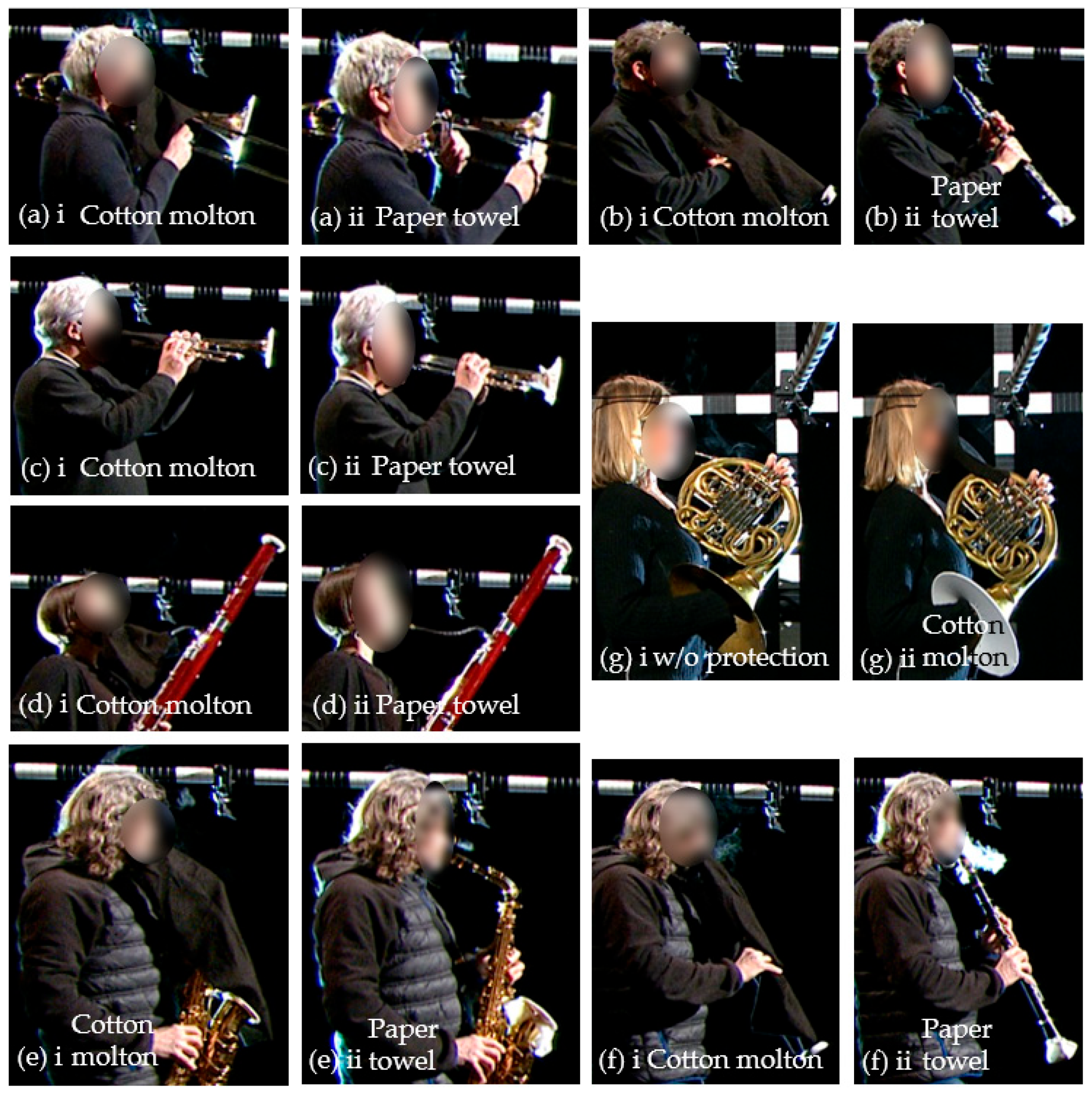


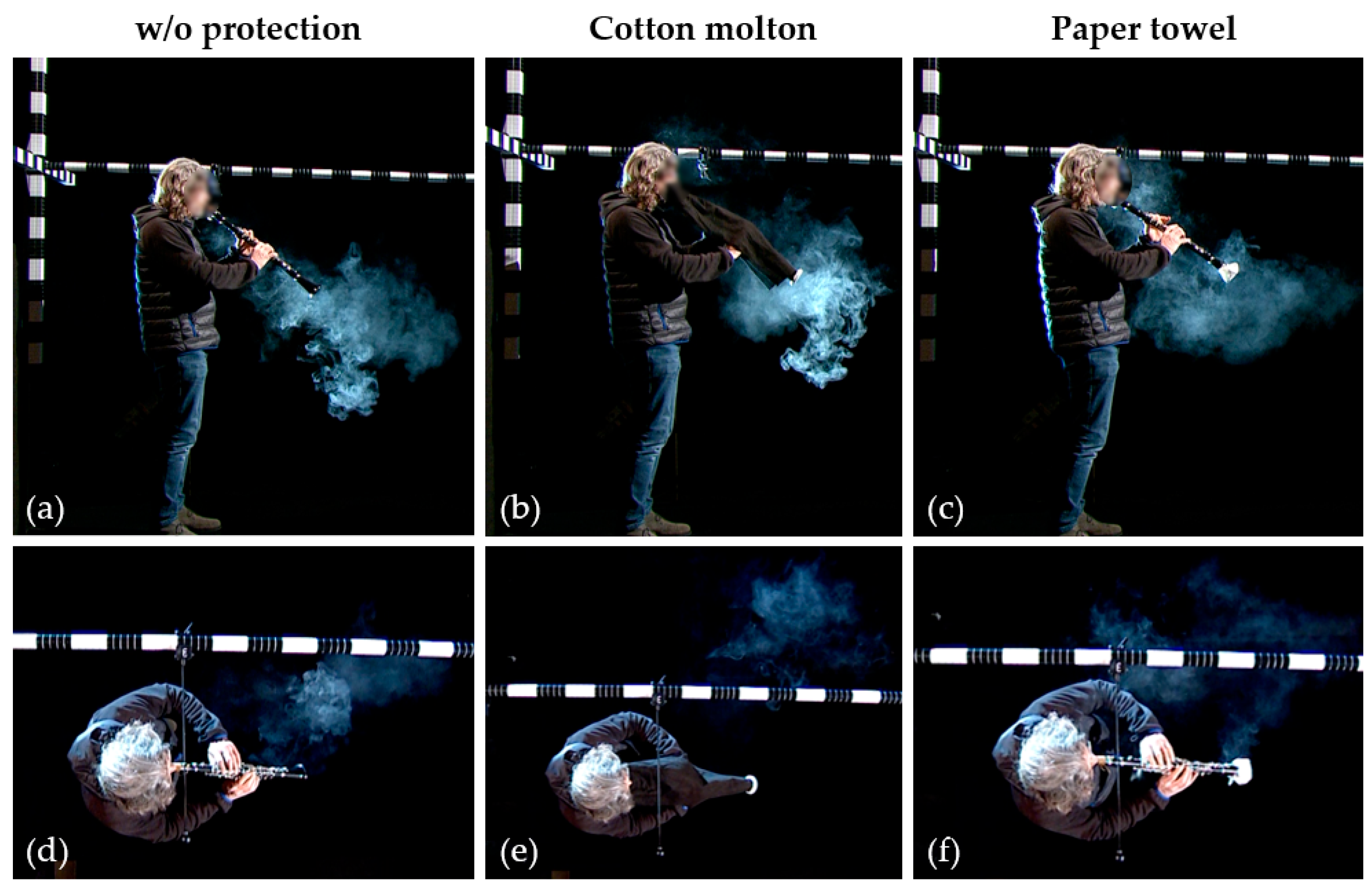

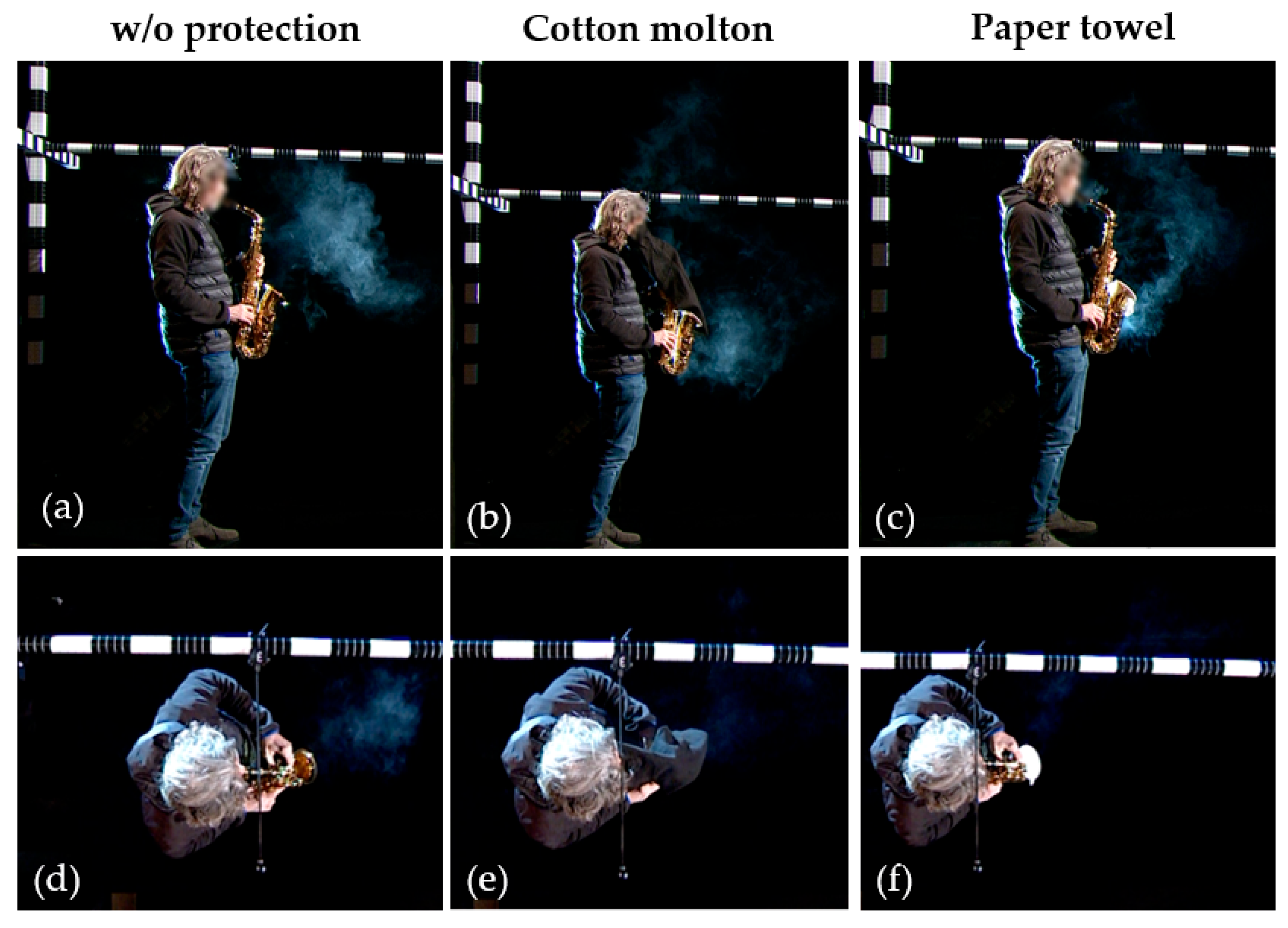



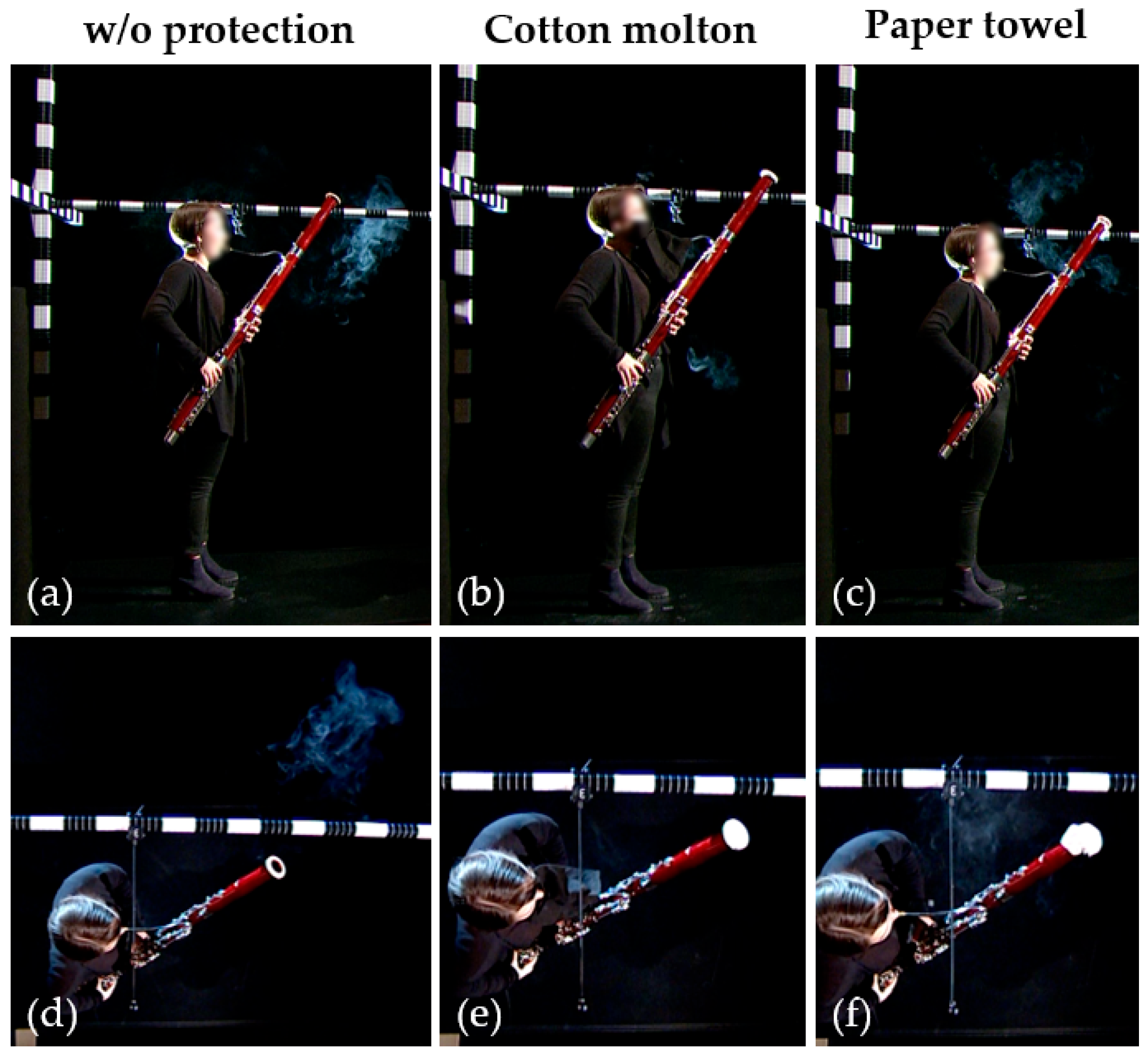

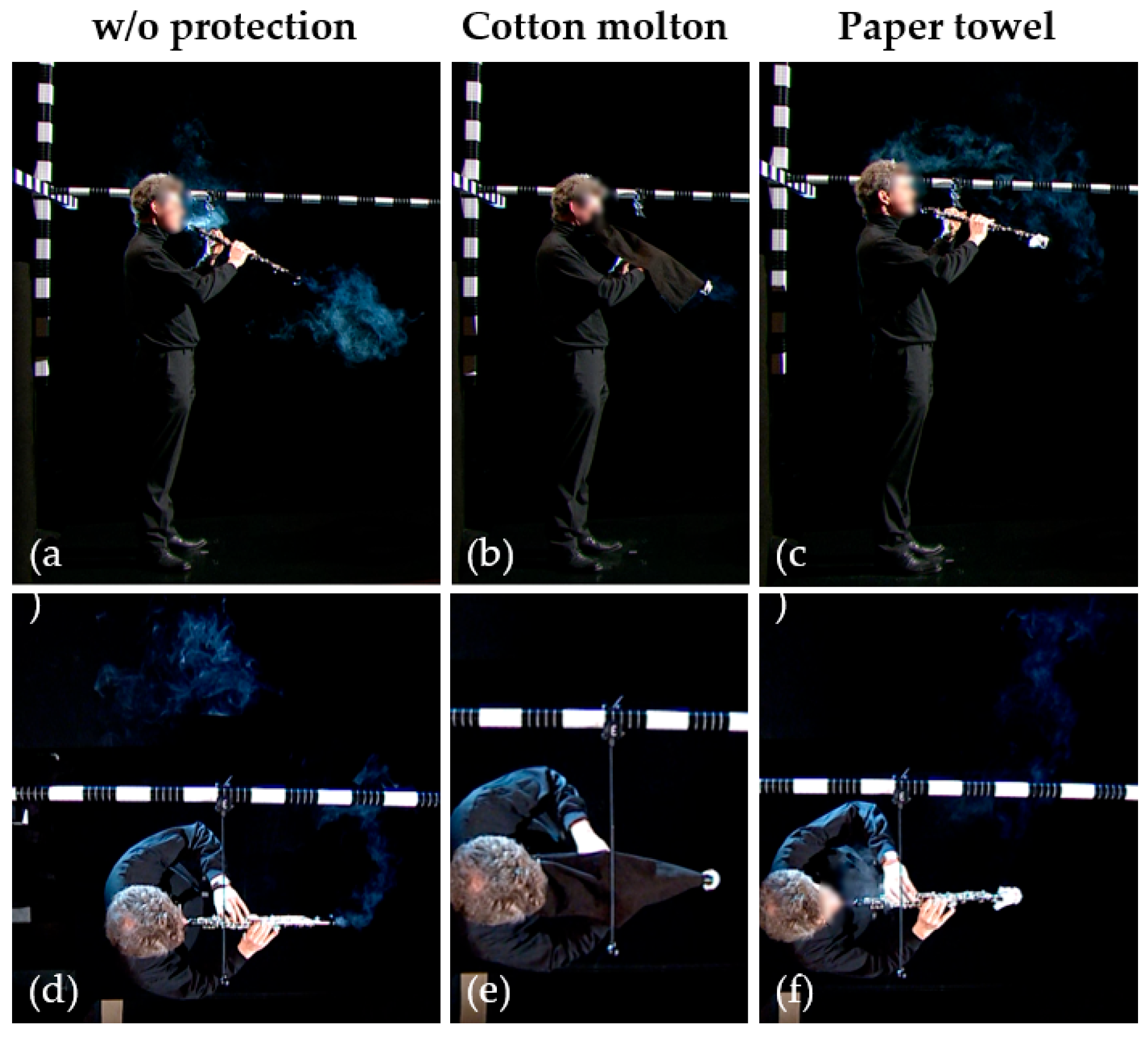



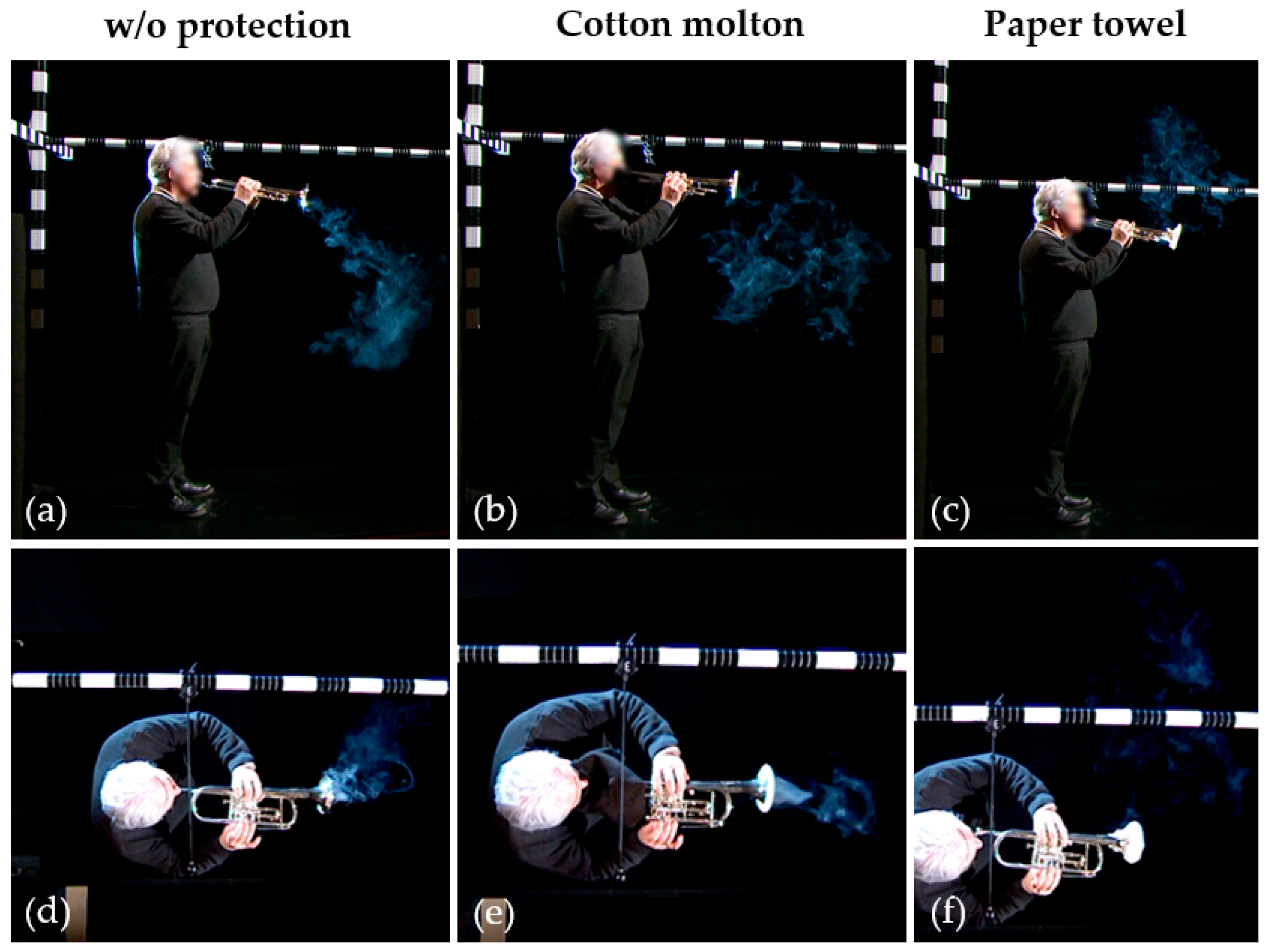

| t0 | x Dimension in m | dy Dimension in m | dz Dimension in m |
|---|---|---|---|
| w/o protection | 0.93 | 0.4 | 0.86 |
| Cotton molton | 0.51 | 0.39 | 0.87 |
| Paper towel | 0.88 | 0.57 | 0.88 |
| tmax | x Dimension in m | dy Dimension in m | dz Dimension in m |
|---|---|---|---|
| w/o protection | 1.24 | 0.46 | 1.12 |
| Cotton molton | 0.72 | 0.53 | 1.1 |
| Paper towel | 1.05 | 0.77 | 1.24 |
| (a) | ||||||
| w/o Protection | x Dimension in m | dy Dimension in m | dz Dimension in m | |||
| t0 in s | tmax in s | t0 in s | tmax in s | t0 in s | tmax in s | |
| Clarinet | 1.63 | 2.29 | 0.33 | 0.49 | 1.29 | 1.33 |
| Saxophone | 1.54 | 1.56 | 0.4 | 0.54 | 0.87 | 1.12 |
| Trombone | 0.97 | 1.29 | 0.95 | 0.96 | 0.50 | 1.2 |
| Bassoon | 0.44 | 0.92 | 0.05 | 0.11 | 1.13 | 1.36 |
| Oboe | 0.45 | 0.72 | 0.48 | 0.52 | 0.64 | 0.92 |
| Horn | 0.88 | 0.92 | 0.29 | 0.29 | 0.85 | 0.94 |
| Trumpet | 0.62 | 0.98 | 0.3 | 0.34 | 0.77 | 0.96 |
| (b) | ||||||
| Cotton Molton | x Dimension in m | dy Dimension in m | dz Dimension in m | |||
| t0 in s | tmax in s | t0 in s | tmax in s | t0 in s | tmax in s | |
| Clarinet | 0.67 | 0.72 | 0.57 | 0.68 | 1.58 | 1.62 |
| Saxophone | 1.25 | 1.57 | 0.37 | 0.4 | 1.94 | 2.02 |
| Trombone | 0.64 | 0.99 | 0.36 | 0.79 | 1.39 | 1.44 |
| Bassoon | 0.16 | 0.25 | 0 | 0 | 0.36 | 1.25 |
| Oboe | 0.17 | 0.17 | 0 | 0 | 0.24 | 0.24 |
| Horn | 0.15 | 0.39 | 0 | 0 | 0.06 | 0.27 |
| Trumpet | 0.49 | 0.92 | 0.24 | 0.25 | 0.49 | 0.86 |
| (c) | ||||||
| Paper Towel | x Dimension in m | dy Dimension in m | dz Dimension in m | |||
| t0 in s | tmax in s | t0 in s | tmax in s | t0 in s | tmax in s | |
| Clarinet | 1.18 | 1.27 | 0.56 | 0.6 | 1.3 | 1.46 |
| Saxophone | 1.28 | 1.31 | 0.24 | 0.3 | 1.17 | 1.44 |
| Trombone | 0.88 | 1.48 | 0.53 | 1.48 | 0.84 | 1.79 |
| Bassoon | 0.7 | 0.74 | 0.55 | 0.55 | 0.65 | 1.16 |
| Oboe | 0.85 | 0.91 | 0.63 | 0.79 | 0.94 | 1.01 |
| Horn | 1.01 | 1.05 | 0.75 | 0.79 | 0.72 | 1.02 |
| Trumpet | 0.28 | 0.6 | 0.73 | 0.89 | 0.53 | 0.8 |
| Friedmann | Post Hoc | |||
|---|---|---|---|---|
| Cotton Molton– w/o Protection | Cotton Molton–Paper Towel | w/o Protection–Paper Towel | ||
| x0 | 0.018 | 0.018 | 0.043 | 0.612 |
| y0 | 0.156 | 0.091 | 0.063 | 0.176 |
| z0 | 0.867 | 0.866 | 0.866 | 0.735 |
| xmax | 0.156 | 0.028 | 0.063 | 0.31 |
| ymax | 0.102 | 0.128 | 0.063 | 0.043 |
| zmax | 0.867 | 0.398 | 0.499 | 0.866 |
Disclaimer/Publisher’s Note: The statements, opinions and data contained in all publications are solely those of the individual author(s) and contributor(s) and not of MDPI and/or the editor(s). MDPI and/or the editor(s) disclaim responsibility for any injury to people or property resulting from any ideas, methods, instructions or products referred to in the content. |
© 2025 by the authors. Licensee MDPI, Basel, Switzerland. This article is an open access article distributed under the terms and conditions of the Creative Commons Attribution (CC BY) license (https://creativecommons.org/licenses/by/4.0/).
Share and Cite
Baron, M.; Tur, B.; Köberlein, M.; Hermann, L.A.; Gantner, S.; Echternach, M.; Kniesburges, S. Analysis of Two Protection Strategies for Reducing Aerosol Expulsion from Wind Instruments. Fluids 2025, 10, 116. https://doi.org/10.3390/fluids10050116
Baron M, Tur B, Köberlein M, Hermann LA, Gantner S, Echternach M, Kniesburges S. Analysis of Two Protection Strategies for Reducing Aerosol Expulsion from Wind Instruments. Fluids. 2025; 10(5):116. https://doi.org/10.3390/fluids10050116
Chicago/Turabian StyleBaron, Miriam, Bogac Tur, Marie Köberlein, Laila Ava Hermann, Sophia Gantner, Matthias Echternach, and Stefan Kniesburges. 2025. "Analysis of Two Protection Strategies for Reducing Aerosol Expulsion from Wind Instruments" Fluids 10, no. 5: 116. https://doi.org/10.3390/fluids10050116
APA StyleBaron, M., Tur, B., Köberlein, M., Hermann, L. A., Gantner, S., Echternach, M., & Kniesburges, S. (2025). Analysis of Two Protection Strategies for Reducing Aerosol Expulsion from Wind Instruments. Fluids, 10(5), 116. https://doi.org/10.3390/fluids10050116





